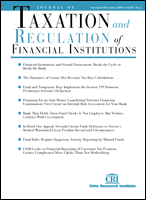Mutual Fund Share Distributions: the Changing Rules of the Game
Author: Patrick D. Sweeney.; Israel Grafstein.
Source: Volume 18, Number 03, January/February 2005 , pp.15-21(7)

< previous article |next article > |return to table of contents
Abstract:
In October 2002, a broker employed by Raymond James Financial Services, Inc. requested a noaction letter from the SEC’s Division of Market Regulation to confirm that a refund by the broker to his customers of a portion of the Rule 12b-1 fees received by the broker in connection with mutual fund shares sold to his customers would not require the customers to register as broker-dealers under the Securities Exchange Act of 1934.1 In the Edward Mahaffy no-action letter,2 the Division of Market Regulation confirmed that, so long as a customer is not separately engaged in activities that are encompassed by the definitions of “broker” or “dealer,” the mere receipt of Rule 12b-1 fee refunds in respect of investments in mutual fund shares would not trigger broker-dealer registration requirements. However, rather than concluding a fairly unremarkable no-action letter at that juncture, the Division of Market Regulation proceeded to convey to Mr. Mahaffy the unsolicited view of the Division of Investment Management that such a refund arrangement might raise issues of compliance by a mutual fund with the policies and provisions of the Investment Company Act of 1940. Citing a much earlier no-action letter that addressed Rule 12b-1 fee refunding arrangements by an investment adviser’s affiliate, rather than by an independent broker,3 the letter relayed the view of the staff of the Division of Investment Management that “a broker-dealer’s practice of rebating to its customers . . . 12b-1 fees paid by the fund to the broker-dealer would be a pertinent factor requiring a board of directors’ full consideration in reaching its conclusion with respect to a fund’s 12b-1 plan, and the staff . . . questions whether a 12b-1 plan under which broker-dealers rebate 12b-1 fees to their customers would benefit the fund and its shareholders.” Edward Mahaffy underscores the complexities that regulators and market participants confront in addressing mutual fund share distribution in multiple regulatory frameworks. What is the point, for example, of continuing to permit the use of mutual fund assets to promote distribution of mutual fund shares when at least some of the selling brokers are refunding a portion of the fees to their customers? Do the refunds imply that the Rule 12b-1 fees charged to the mutual funds are unnecessarily high? Or are the independent brokers simply sharing their own revenues with their customers in order to achieve a competitive advantage in the marketplace? If so, how would revenue sharing be relevant to the approval of a mutual fund’s Rule 12b-1 plan by its independent directors? And how are the independent directors expected to monitor, or police, thecustomer relationships of independent brokers with mutual fund investors? This article summarizes the treatment of significant distribution issues during the 18 months following Edward Mahaffy.Keywords:
Affiliations:
1: Herrick, Feinstein LLP; 2: Herrick, Feinstein LLP.